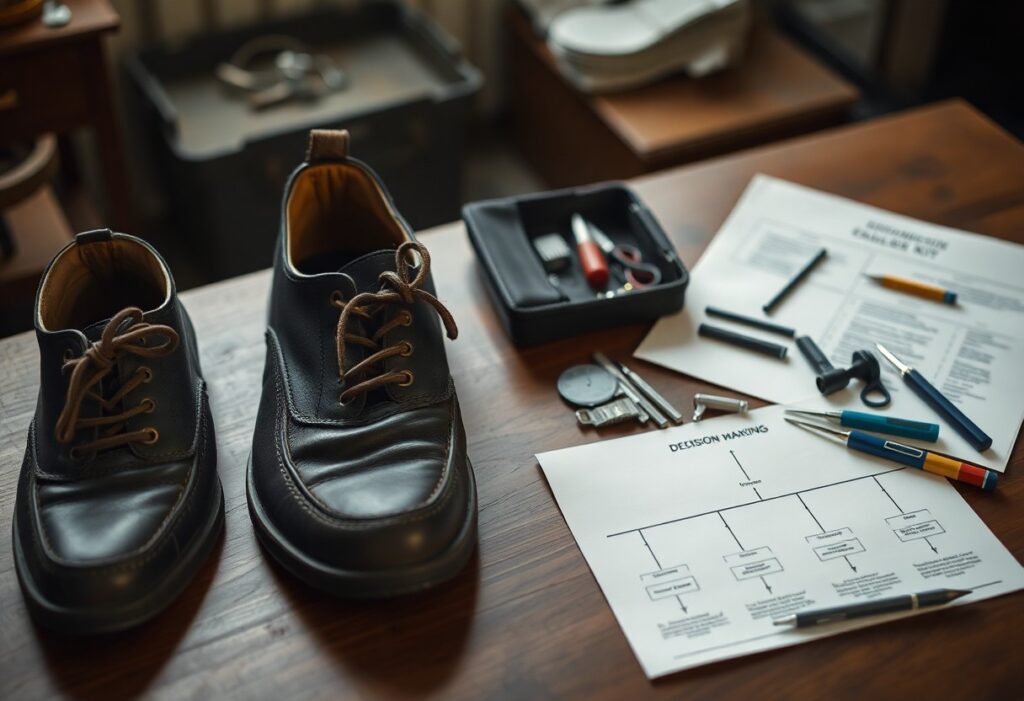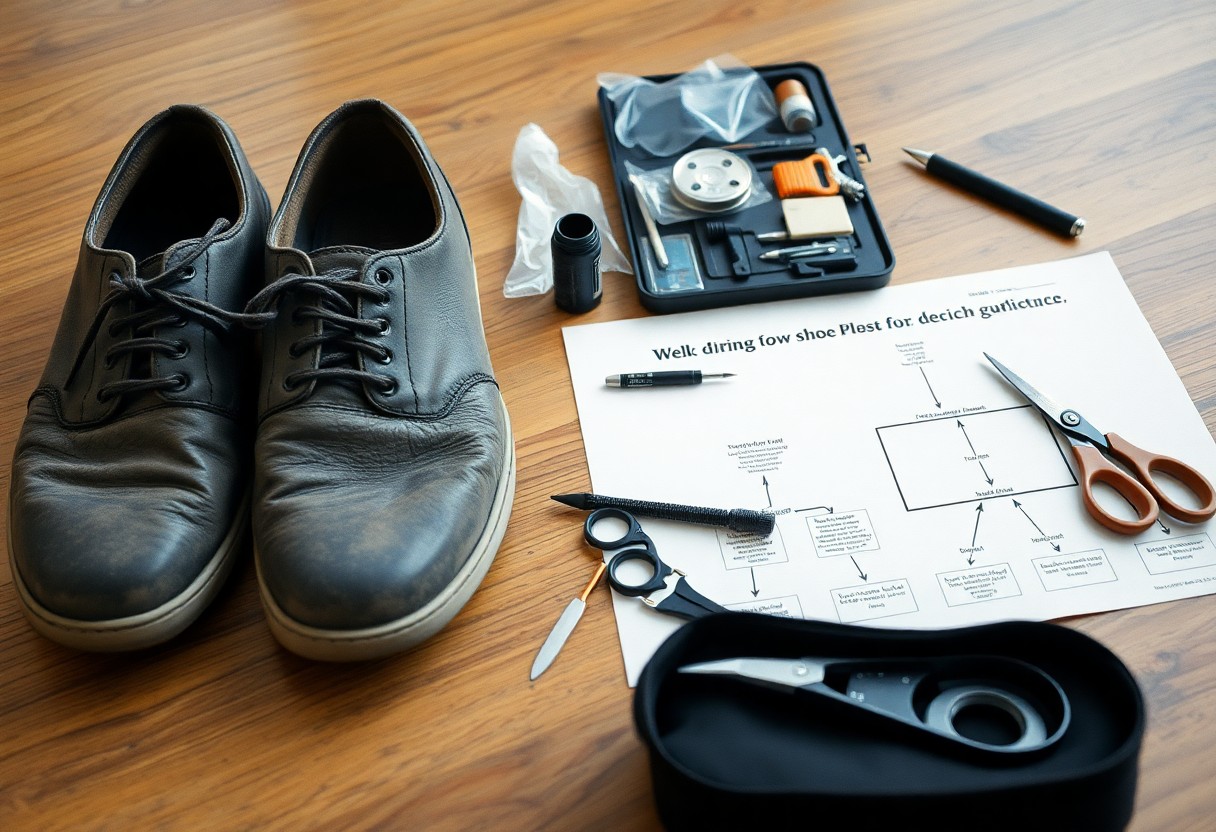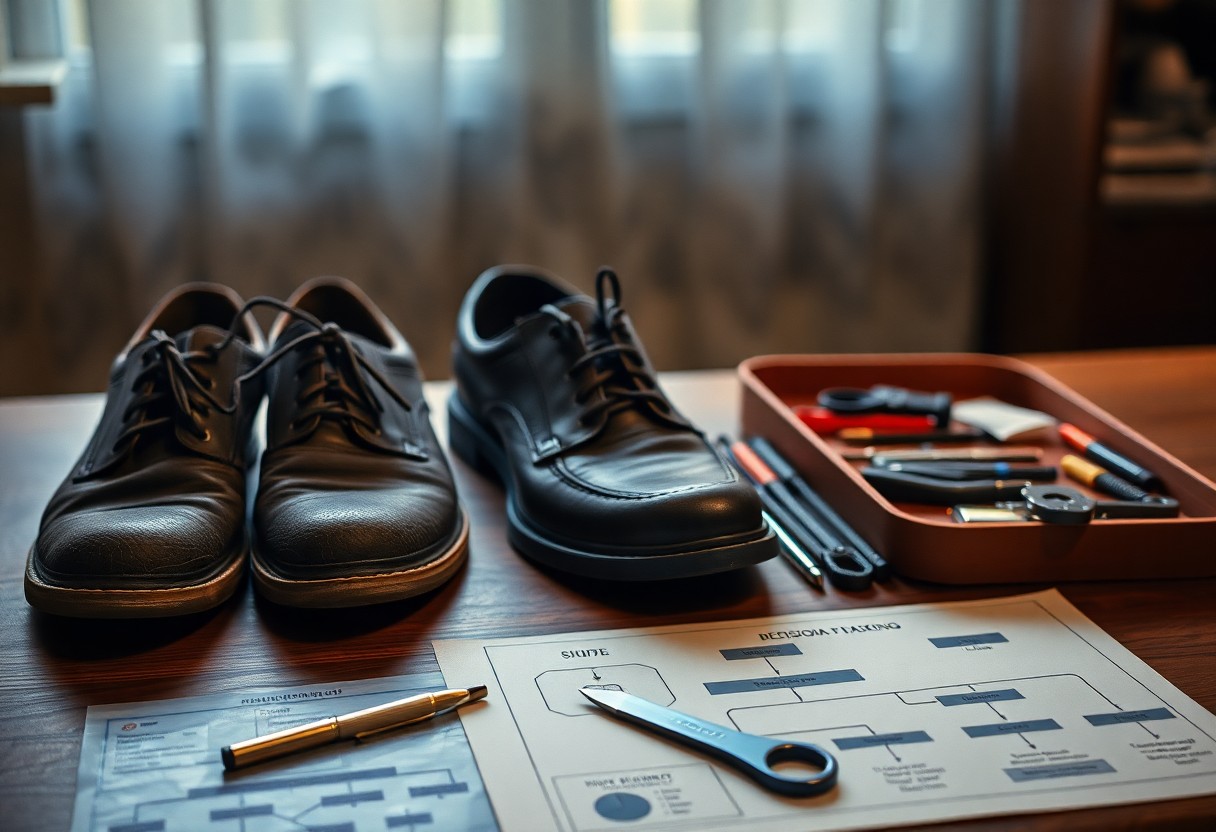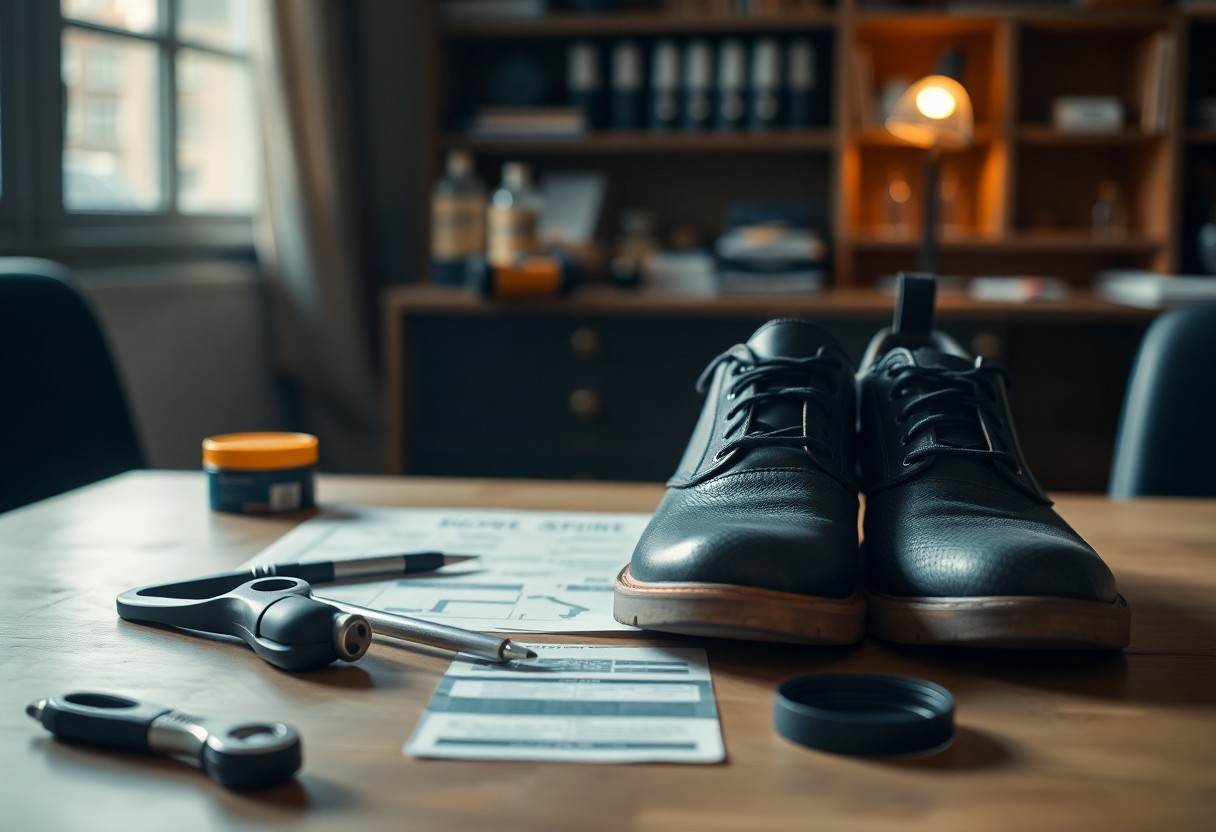
This comprehensive guide aims to equip you with the knowledge necessary to make well-informed decisions about the future of your footwear. When your favorite shoes start showing signs of wear, the choice between repairing your shoes or opting for a new pair can have significant implications for your budget and can also extend the lifespan of your favorite footwear. Several critical factors should influence your decision-making process, such as the original quality of your shoes, the extent of the damage incurred, and the costs associated with repairs. For example, if you own high-quality leather shoes that have experienced sole wear or heel damage, opting to repair them could be a wise investment. Conversely, if the upper leather is severely compromised or multiple structural issues arise, replacement may be the more prudent choice. By understanding these essential considerations, you can maintain your shoes more effectively and make financially sound decisions.

Recognizing and Analyzing Common Types of Shoe Damage
Before you make decisions about repairing or replacing your shoes, it’s crucial to become familiar with the common types of damage that can affect your beloved footwear. Shoes can incur damage in several critical areas, including soles, heels, uppers, and structural components. By recognizing these issues early, you can enhance your ability to make informed decisions about necessary repairs and avoid further complications.
| Damage Type | Repair Possibility |
| Sole Wear | Usually repairable |
| Heel Damage | Highly repairable |
| Upper Leather Cracks | Limited repair options |
| Structural Issues | Case-dependent |
| Cosmetic Damage | Mostly repairable |
Proactively Addressing Common Sole and Heel Problems for Longer Wear
The soles of your shoes often display the first signs of wear, with heel deterioration being one of the most frequent issues encountered. It’s essential to give your shoes immediate attention if you notice uneven wear patterns or if the edges of your heels appear worn down. Promptly addressing these concerns can help prevent further damage and significantly improve the overall comfort of your footwear, leading to a better experience with every step you take.
Identifying Upper Leather Issues and Their Consequences
If you own leather shoes, you may face challenges such as creasing, cracking, and scratches. These problems typically arise from daily wear and insufficient care. It’s vital to understand that the severity of leather damage can vary widely. Some shoes may only exhibit surface scratches that are relatively simple to repair, while others may show deeper cracks that complicate the repair process considerably. Recognizing the extent of the damage will help you determine the best course of action.
Comprehending the Effects of Structural Damage on Footwear
Common structural issues in shoes encompass separated soles, broken shanks, and damaged welts. The structural integrity of your shoes directly affects both comfort and safety. Repairs to these structural components typically require professional expertise. A skilled cobbler can assess whether the damage is repairable or if opting for replacement is the more sensible choice based on the level of damage observed.
Managing Cosmetic Damage for a Renewed Appearance
Cosmetic damage refers to surface scuffs, fading color, and minor scratches. The good news is that your shoes can often be revitalized with the right care and treatment. Cosmetic repairs are usually among the most cost-effective options available. With professional cleaning and refinishing services, your shoes can regain their nearly new appearance, significantly enhancing their aesthetic appeal and prolonging their usability.

Essential Factors to Consider Before Committing to Repairs or Replacement
Before deciding whether to repair or replace your shoes, it’s essential to evaluate several critical factors. These factors include the age and condition of the shoes, a comparison between repair costs and the price of new shoes, the quality of materials used in the shoes, and any personal attachment you may have to them. Each decision should reflect a mix of practical considerations and economic implications, ensuring you make a choice that aligns with your needs.
- Overall condition assessment
- Cost comparison
- Material quality check
- Sentimental value evaluation
Evaluating the Age and Overall Condition of Your Shoes
If your shoes are relatively new—say, less than two years old—and show minimal wear aside from some sole or heel damage, repairs may present a worthwhile option. Take the time to examine the upper materials for any signs of cracks, assess the condition of the insoles, and scrutinize the stitching integrity to ensure that your footwear is still in good shape for continued use.
Conducting a Cost Comparison: Repairing Versus Buying New
| Basic Repairs | €15-60 |
| Major Repairs | €70-200 |
| New Quality Shoes | €200-500 |
As a general rule, repair costs should not exceed 50% of the price of new shoes for the decision to be economically viable. This guideline serves as an essential benchmark as you weigh your options, ensuring that your financial investment is sound.
| Heel Replacement | €15-30 |
| Half Sole Repair | €70-120 |
| Full Sole Repair | €130-200 |
| Heel Lining | €25-60 |
Assessing Shoe Quality and Material Durability
The construction type and quality of materials in your shoes are critical factors to consider when making your decision. Welted shoes, particularly those made from full-grain leather, are generally more amenable to repairs compared to cemented shoes crafted from synthetic materials. The repairability of a shoe is often closely tied to its construction method, which can dictate how many times they can be repaired.
High-quality welted shoes can typically withstand multiple repairs, while less expensive cemented constructions might not justify the effort and expense involved in fixing them. Understanding the materials and construction will help you make better choices regarding whether to repair or replace your footwear.
Taking Sentimental Value into Account in Your Decision
Even shoes that have seen better days may be worth repairing if they hold special significance or are rare vintage finds that mean something to you. The comfort level, perfect fit, and emotional attachment to your shoes can justify higher repair costs. While weighing the practical aspects of your decision, consider these personal values that may influence your choice, ensuring that your sentimental attachments are honored.
Determining the Appropriate Times to Repair Your Footwear
Your decision to repair shoes should be based on their overall condition and intrinsic value. If your footwear features quality leather uppers and possesses solid construction, repairs can significantly extend their functional life. Consider undertaking repairs when damage is limited to specific areas, such as soles or heels, while the overall structural integrity remains intact, allowing you to enjoy your footwear for longer.
Identifying Conditions That Are Ideal for Repairing Footwear
There are various issues that indicate your shoes are worth repairing, such as worn soles, damaged heels, loose stitching, and minor leather scuffs. Your shoes are good candidates for repair if the upper leather remains intact and the insole shows no signs of cracking. Basic repair costs generally range from $15-60, making them a financially sensible option for maintaining your footwear.
Understanding Scenarios That Justify Cost-Effective Repairs
The optimal time to repair your shoes is when the cost of repair is less than 50% of the price of new shoes. Higher-end leather shoes, especially those with welted constructions, are usually worth repairing, particularly when basic resoling ($70-120) is significantly less than purchasing new high-quality footwear. Conditions that warrant repairs include high-quality construction, minimal wear on the upper parts, and damage confined to easily replaceable components. Ensure your shoes have intact insoles and uncracked upper leather to justify repair costs ranging from $25 for heel replacement to $200 for full sole repairs.
Anticipating the Advantages of Professional Repairs
With properly executed repairs, you can expect restored functionality and a significantly extended lifespan for your footwear. Well-repaired shoes can provide several additional years of wear, especially with quality resoling or heel replacement services. The expected longevity of repairs can vary based on the type performed: heel replacements may last anywhere from 6 months to 2 years, while resoled shoes can offer an additional 2-5 years of service with proper care. Your repaired shoes should feel comfortable and stable, maintaining their original fit and support, allowing you to enjoy them for many more adventures.
Identifying When It’s Necessary to Purchase New Shoes
It becomes essential to replace your footwear when repair costs exceed 50% of the price of new shoes or when structural damage renders repairs impractical. Key warning signs to look for include severe cracks in the upper leather, compromised insoles, or multiple repair needs arising at once, all of which indicate that it may be time to start shopping for replacements.
Recognizing Situations Where Repair is Not an Option
Certain types of damage are beyond repair, and it’s crucial to identify them. Be vigilant for deep cracks in multiple areas of the upper leather, severely damaged insoles, or widespread structural failures. Upon noticing these issues, it’s wise to shift your focus towards finding a suitable replacement rather than attempting to repair what may be irreparable.
Financial Analysis of Repair Versus Replacement Decisions
Not all repairs are financially equivalent. Basic repairs such as heel replacements (€15-30) and sole repairs (€70-120) can be economical choices for maintaining quality shoes. However, if you find that multiple repairs are needed simultaneously, it may indicate that it’s time to seriously consider new shoes. Given that quality welted shoes typically range from €200-500, comparing repair costs to the original price is essential. If total repair costs surpass half the price of new shoes, then purchasing new footwear often becomes the more sensible financial choice.
Prioritizing Safety When Evaluating Footwear Condition
Worn-out shoes can pose a significant risk of foot injuries and accidents. Indicators such as completely smooth soles, exposed steel toe caps, or compromised water resistance suggest that your shoes are no longer providing adequate protection. Safety considerations should take into account your working environment; if you operate in hazardous conditions or require specific safety features, even minor structural damage can render your shoes unsafe for regular use. It’s paramount not to compromise your safety by continuing to wear damaged footwear.

Your Systematic Step-by-Step Guide for Shoe Assessment
To keep your shoe evaluation organized and efficient, follow this systematic approach to determine whether to repair or replace your shoes, helping you make the most informed decision possible.
| Repair Indicators | Replacement Indicators |
| Worn soles (no welt damage) | Cracked insoles |
| Heel wear (surface only) | Multiple upper cracks |
| Minor scratches | Severe structural damage |
Conducting a Thorough Damage Evaluation for Informed Decisions
The first step in assessing your shoes is to examine them in adequate lighting. Look closely at the soles, heels, upper leather, and insoles for any signs of wear and tear. A half sole replacement typically costs between €70-120, while a full sole repair may range from €130-200, making it important to understand the financial implications of your choices.
- Sole integrity check
- Upper leather inspection
- Heel stability assessment
- Insole condition evaluation
Maximizing Professional Consultations for Optimal Outcomes
Seeking a damage assessment from a qualified professional can greatly enhance your ability to make informed decisions about your shoes’ future. Here are essential tips to keep in mind when consulting a cobbler:
- Obtain multiple opinions if necessary
- Inquire about repair costs upfront
- Request timeline estimates for the repair process
- Compare repair estimates with new shoe prices
When visiting a cobbler, it’s advisable to bring both shoes for a comprehensive assessment. Document any specific issues you’ve encountered and ask about warranty coverage for proposed repairs. Understanding that a professional evaluation typically costs between €15-30 can aid in budgeting for this service while ensuring you receive the best possible advice.
Exploring Professional Repair Solutions for Your Footwear
To prolong the life of your shoes, utilizing professional repair services can offer specialized solutions for a variety of shoe-related issues. Local cobblers are equipped to handle everything from basic resoling to complex leather repairs, often at a fraction—30-50%—of the cost of purchasing new shoes. The decision to repair ultimately hinges on the shoe’s quality and the extent of the damage incurred.
Discovering the Range of Shoe Repair Services Available
| Service | Average Cost |
|---|---|
| Heel Replacement | $15-30 |
| Full Sole Replacement | $50-70 |
| Leather Patching | $20-40 |
| Stitching Repair | $10-25 |
| Stretching | $15-20 |
- Resoling – Complete sole replacement
- Heel repair – Replacing worn heel tips
- Leather work – Patching and restoration
- Stretching – Adjusting shoes for a better fit
Finding a Qualified Cobbler for Your Repair Needs
When searching for a reliable shoe repair professional, prioritize certified cobblers with positive customer reviews and a minimum of five years of experience. The best options typically include shoe repair shops equipped with specialized tools and a proven track record in handling your specific type of footwear, ensuring that you receive high-quality service.
For instance, you can verify a cobbler’s credentials by checking their certification from the Shoe Service Institute of America, assessing the cleanliness of their workshop, and asking to see examples of their previous repair work. Local shoe stores often have partnerships with trusted repair professionals and can provide reliable recommendations based on your specific needs.
Making Empowered Decisions for Your Footwear Needs
With the information provided, you are now equipped to make better decisions regarding whether to repair or replace your shoes. Generally, shoes are repairable when the damage is confined to the soles, heels, buckles, or surface scratches. In contrast, consider purchasing new footwear when you identify cracks in the upper leather or insole, as these repairs often come at a higher cost than replacement and rarely yield satisfactory results. The key lies in maintaining your shoes appropriately and addressing repairs promptly. By carefully weighing repair costs against the shoe’s overall value and condition, you can extend the life of your footwear while saving money in the long run.
Frequently Asked Questions (FAQ)
Q: How can I determine if my shoes are worth repairing or if I should buy new ones?
A: Evaluate the following key factors: If your shoes feature high-quality leather uppers without cracks and only require repairs to the soles or heels, then repairs are advisable. Ensure that the total repair cost is less than 50% of the price of new shoes. Basic repairs such as heel replacements ($20-35) and resoling ($70-120) generally present sensible options for quality shoes. However, if the upper leather shows cracks, the insole is damaged, or if repairs exceed half the price of new footwear, it’s time to consider purchasing new shoes.
Q: Which shoe repairs provide the best value for the cost?
A: The most cost-effective repairs include heel replacements ($20-35), heel lining repairs ($25-60), and simple regluing of separated parts ($10-20). These types of repairs can significantly extend the lifespan of your shoes at a minimal expense. Half-sole replacements ($70-120) also present good value for quality welted shoes, ensuring you get the most from your investment. It’s crucial not to delay necessary repairs, as this can lead to further damage that may ultimately require complete shoe replacement.
Q: What types of shoe damage are generally irreparable?
A: There are three primary types of damage that make repairs impractical: 1. Deep cracks in the upper leather, particularly around creasing areas 2. Structural cracks in the insole 3. Multiple significant damages that would require repair costs exceeding the price of new shoes. These issues compromise the fundamental structure of the shoe, and repairs often yield unsatisfactory results. In such cases, purchasing new shoes is typically the better alternative.
The Article Guide on deciding when to repair shoes versus buying new practical tips for making the right choice appeared first on My Shoes Finder
The Article Deciding to Repair Shoes or Buy New: Essential Tips Was Found On https://limitsofstrategy.com


It’s interesting to see the spotlight on the decision-making process between shoe repairs and buying new. I think many of us have faced that moment of contemplation when our beloved footwear starts to show signs of wear and tear. Personally, I’m a huge fan of a good pair of boots that I’ve worn for years. They’ve been through all sorts of adventures with me, from muddy hikes to casual days out, and I can’t help but feel a bit nostalgic whenever I consider replacing them.
I completely relate to that moment of contemplation. There’s something really special about the stories our shoes carry with them. It’s almost like they become part of who we are over the years, especially when they’ve shared in so many experiences. Your boots sound like they’ve truly been through it all.
Your guide presents such an enlightening approach to shoe care, and I resonate deeply with the thought process you outlined. The decision between repairing and replacing footwear feels so personal, drawing on both our sentimental attachments to certain pairs and our practical lifestyles.
Your exploration of the decision-making process regarding shoe repair versus replacement raises some insightful considerations that I find particularly relevant in today’s consumer culture. We often feel swept away by the convenience of buying new items, especially with the abundance of fast fashion available. Yet, the idea of repairing our favorite shoes not only extends their lifespan but can also lead to a more sustainable approach to consumption.